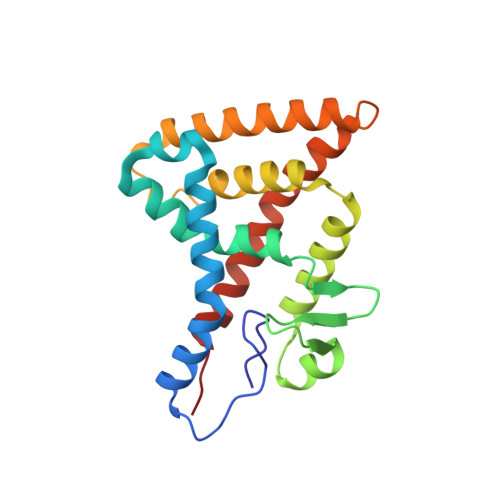Structure of REV-ERB beta Ligand-binding Domain Bound to a Porphyrin Antagonist.
Matta-Camacho, E., Banerjee, S., Hughes, T.S., Solt, L.A., Wang, Y., Burris, T.P., Kojetin, D.J.(2014) J Biol Chem 289: 20054-20066
- PubMed: 24872411
- DOI: https://doi.org/10.1074/jbc.M113.545111
- Primary Citation of Related Structures:
4N73 - PubMed Abstract:
REV-ERBα and REV-ERBβ are members of the nuclear receptor (NR) superfamily of ligand-regulated transcription factors that play important roles in the regulation of circadian physiology, metabolism, and immune function. Although the REV-ERBs were originally characterized as orphan receptors, recent studies have demonstrated that they function as receptors for heme. Here, we demonstrate that cobalt protoporphyrin IX (CoPP) and zinc protoporphyrin IX (ZnPP) are ligands that bind directly to the REV-ERBs. However, instead of mimicking the agonist action of heme, CoPP and ZnPP function as antagonists of REV-ERB function. This was unexpected because the only distinction between these ligands is the metal ion that is coordinated. To understand the structural basis by which REV-ERBβ can differentiate between a porphyrin agonist and antagonist, we characterized the interaction between REV-ERBβ with heme, CoPP, and ZnPP using biochemical and structural approaches, including x-ray crystallography and NMR. The crystal structure of CoPP-bound REV-ERBβ indicates only minor conformational changes induced by CoPP compared with heme, including the porphyrin ring of CoPP, which adopts a planar conformation as opposed to the puckered conformation observed in the heme-bound REV-ERBβ crystal structure. Thus, subtle changes in the porphyrin metal center and ring conformation may influence the agonist versus antagonist action of porphyrins and when considered with other studies suggest that gas binding to the iron metal center heme may drive alterations in REV-ERB activity.
Organizational Affiliation:
From the Department of Molecular Therapeutics, The Scripps Research Institute, Jupiter, Florida 33418 and.















